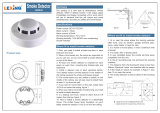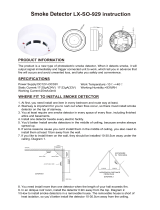3.INSTALLATION INSTRUCTIONS
CAUTION: THIS UNIT IS SEALED. THE COVER IS NOT REMOVABLE!
1). Remove the mounting plate from the back of the alarm by holding the mounting
plate and twist the alarm in the direction indicated by the “REMOVE” arrow see
Figure 6.
2). To ensure aesthetic alignment of the alarm with the hallway, the “A” line on the
mounting plate should be parallel with the hallway when ceiling mounting.
3). After selecting the proper smoke alarm location as described in Section 1, attach the
mounting plate to the ceiling as shown in Figure 4. Use the screws and anchors
provided to secure the mounting plate.
4). When installing the battery, press the battery reminder finger down into the battery
compartment and install the battery (see Figure 5).
CAUTION! IF THE BATTERY REMINDER FINGER IS NOT HELD DOWN IN
THE BATTERY COMPARTMENT BY THE BATTERY, THE UNIT WILL NOT
ATTACH TO THE MOUNTING BRACKET.
5). Alignment marks are provided on the edge of the trim plate and the alarm. After
installing the mounting plate, place the alarm on the mounting plate with the
alignment marks lined up. Twist the alarm in the direction indicated by the “ON”
arrow on the alarm cover (see Figure 6) until it locks in place.
6). Tamper Resist Feature: To make your smoke alarm tamper resistant, a tamper resist
feature has been provided. Activate the tamper resist feature by breaking out the
block in the trim ring (see Figure 7). When the blocks are broken out, the tamper
resist tab is allowed to engage the mounting bracket. Rotate the alarm onto the
mounting bracket until you hear the tamper resist tab snap into place, locking the
alarm on the mounting bracket. Using the tamper resist feature will help to deter
children and others from removing the alarm from bracket. NOTE: To remove the
alarm when the tamper resist tab is engaged, press down on the tamper resist tab
with a screwdriver, and rotate the alarm off of the bracket (see Figure 8).
CAUTION! EARLY WARNING FIRE DETECTION IS BEST ACHIEVED BY THE
INSTALLATION OF FIRE DETECTION EQUIPMENT IN ALL ROOMS AND AREAS OF
THE HOUSEHOLD AS FOLLOWS:
A SMOKE ALARM INSTALLED IN EACH SEPARATE SLEEPING AREA (see Figure 2
and Recommended Locations to Install the Alarm) AND HEAT OR SMOKE
ALARMS IN THE LIVING ROOM, DINING ROOM, KITCHEN, HALLWAYS, ATTIC,
BOILER ROOM, CLOSETS, UTILITY STORAGE ROOM, CELLAR, AND ATTACHED
GARAGE.
2. LOCATIONS TO AVOID
• In the garage. Products of combustion are present when you start your car.
• In front of forced air supply ducts used for heating and air conditioning, near ceiling
fans,or other high air flow areas.
• Less than 10cm (4”) from the peak of an ‘A’ frame type ceiling.
• In an area where the temperature may fall below 0°C or rise above 40°C such as
garages and unfinished attics; this should also include electrical boxes exposed to
these environments..
• In dusty areas. Dust particles may cause nuisance alarm or failure to alarm.
• In very humid areas. Moisture or steam can cause nuisance alarms.
• In areas where the Relative Humidity (RH) is above 93%.
• Near fluorescent lights. Electronic “noise” may cause nuisance alarms.
• In insect infested areas
• Smoke alarms should not be installed within 0.9m (3ft) of the following: the door to
a kitchen, the door to a bathroom containing a tub or shower, ceiling or whole house
ventilating fans or other high air flow areas..
• Kitchens: Normal cooking may cause nuisance alarms. If a kitchen alarm is desired, it
should have an alarm silence feature or be a photoelectric type.
• Smoke alarms are not to be used with detector guards unless the combination larm
and guard) has been evaluated and found suitable for that purpose.
NOTE: This model is not suitable for use in recreational vehicles or boats.
















